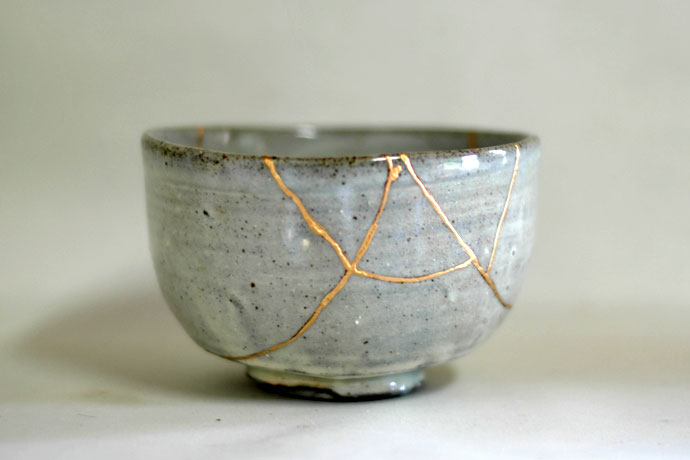 Life is a never ending cycle of falling down, healing and getting back up. In Aikido we call that taking ukemi. As these scrapes, bumps and bruises heal, we have the tendency to try and hide them as if this damage some how defines us in a negative way. These battle scars do more than define who we are - they makes us into who we become. If we try and hide them, then we tend to take that negative path in life. If we display them for all too see then we can use them as fodder to make us stronger.
It is natural, I suppose, to want to hide one's flaws and only project one's accolades or strengths. In chado or Japanese tea ceremony it is the exact opposite. One's flaws are seen as the things which makes us human and this can be clearly seen when a tea bowl is broken. Rather than throw it away, it is sent out to be repaired. The bowl is painstakingly put back together with a sort of gold glue called kintsugi (金継ぐ) or gold patch. However, the bowl isn't repaired back to "new" where one wouldn't even be able to see where the original damage was, but in some sense made better by the repair. This repair, therefore, enhances its beauty.
Life is a never ending cycle of falling down, healing and getting back up. In Aikido we call that taking ukemi. As these scrapes, bumps and bruises heal, we have the tendency to try and hide them as if this damage some how defines us in a negative way. These battle scars do more than define who we are - they makes us into who we become. If we try and hide them, then we tend to take that negative path in life. If we display them for all too see then we can use them as fodder to make us stronger.
It is natural, I suppose, to want to hide one's flaws and only project one's accolades or strengths. In chado or Japanese tea ceremony it is the exact opposite. One's flaws are seen as the things which makes us human and this can be clearly seen when a tea bowl is broken. Rather than throw it away, it is sent out to be repaired. The bowl is painstakingly put back together with a sort of gold glue called kintsugi (金継ぐ) or gold patch. However, the bowl isn't repaired back to "new" where one wouldn't even be able to see where the original damage was, but in some sense made better by the repair. This repair, therefore, enhances its beauty.
In Aikido, we fall down and we get back up - it is part of the training. The trials and tribulations of life's journey do add up, but they make us who we are - the person we have become. We can either get back up and use it to make us stronger or hide them and make ourselves weaker. We are all infinitely stronger than we think. How do I know that? Well, you are still here, right?
Below is a nice video explaining kintsugi in further detail.
https://vimeo.com/90734143
